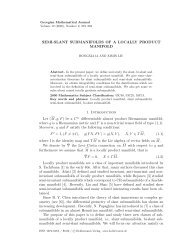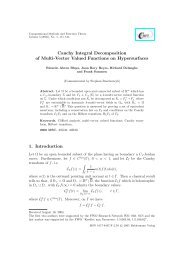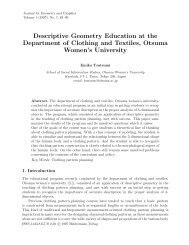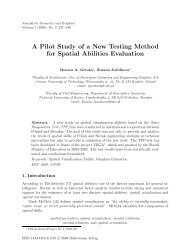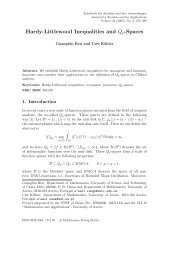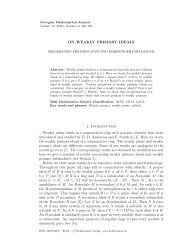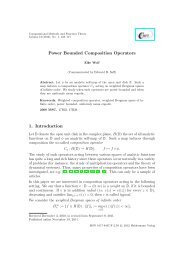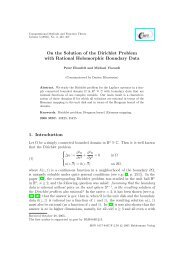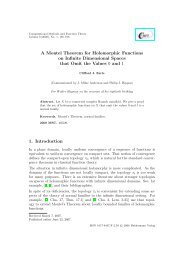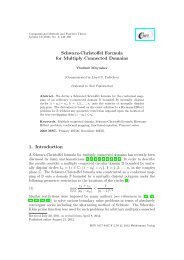Function Spaces as Dirichlet Spaces (About a Paper by Maz'ya and ...
Function Spaces as Dirichlet Spaces (About a Paper by Maz'ya and ...
Function Spaces as Dirichlet Spaces (About a Paper by Maz'ya and ...
You also want an ePaper? Increase the reach of your titles
YUMPU automatically turns print PDFs into web optimized ePapers that Google loves.
<strong>Function</strong> <strong>Spaces</strong> <strong>as</strong> <strong>Dirichlet</strong> <strong>Spaces</strong> 9<br />
Nagel discussed in [19, 20] the rotationally invariant analogue of Lemma 3.2.<br />
Lemma 3.3. Let g : [0, ∞] → [0, ∞] be a monotone incre<strong>as</strong>ing concave function<br />
<strong>and</strong> define µ(t) := ∫ t ∫ ∞<br />
g(s)/s 2 ds dr ∈ [0, ∞]. Then<br />
0 r<br />
( ∫∫<br />
( 1<br />
) ) 1<br />
dx dy<br />
|u(x + y) − u(x)| 2 2<br />
g<br />
R n ×R |y| n 2 |y| n<br />
( ∫<br />
) (19)<br />
1<br />
∼ |û(ξ)| 2 µ(|ξ| 2 2<br />
) dξ<br />
R n<br />
are equivalent (semi-)norms on S(R n ).<br />
Let us now consider the rotationally invariant c<strong>as</strong>e. Comparing (16) with<br />
(19) we would like to relate<br />
( 1<br />
) 1<br />
m(t) with g<br />
<strong>and</strong> f(|ξ| 2 ) with µ(|ξ| 2 ).<br />
t t n/2<br />
Lemma 3.4. Let g(t) = ∫ ∞ t<br />
ρ(ds) be a complete Bernstein function. Then<br />
0+ s+t<br />
the functions r ↦→ g(r −1 ) <strong>and</strong> r ↦→ r −n/2 g(r −1 ) are completely monotone. In<br />
particular, we have the representations<br />
( 1<br />
)<br />
g =<br />
r<br />
( 1<br />
)<br />
r −n/2 g =<br />
r<br />
∫ ∞<br />
0<br />
∫ ∞<br />
0<br />
( ∫ ∞<br />
e −xr −x/s ρ(ds)<br />
e<br />
s<br />
0+<br />
( 1<br />
e −xr Γ ( )<br />
n<br />
2<br />
∫ ∞<br />
0+<br />
)<br />
dx (20)<br />
s n/2−1 e −x/s ∫ x/s<br />
0<br />
)<br />
y n/2−1 e y dy ρ(ds) dx. (21)<br />
Proof. Since the formulae (20) <strong>and</strong> (21) prove that r ↦→ r −n/2 g(r −1 ), n 0, is<br />
completely monotone, it is enough to establish these two representations.<br />
From the definition of g we have<br />
Since we can write<br />
0+<br />
( 1<br />
)<br />
g =<br />
r<br />
∫ ∞<br />
0+<br />
1<br />
r<br />
s + 1 r<br />
ρ(ds) =<br />
∫<br />
1<br />
∞<br />
rs + 1 = e −t(rs+1) dt =<br />
0<br />
0<br />
∫ ∞<br />
0+<br />
∫ ∞<br />
0<br />
0<br />
1<br />
rs + 1 ρ(ds).<br />
e −x/s e −xr dx s<br />
we can apply Tonelli’s Theorem to find<br />
( 1<br />
) ∫ ∞ ∫ ∞<br />
g = e −x/s e −xr dx ∫ ∞<br />
( ∫ ∞<br />
)<br />
r s ρ(ds) = e −xr −x/s ρ(ds)<br />
e dx<br />
s<br />
which proves (20). To prove (21), we use the elementary identity<br />
r −n/2 = 1<br />
Γ ( )<br />
n<br />
2<br />
∫ ∞<br />
0<br />
0+<br />
x n/2−1 e −rx dx, n > 0,



